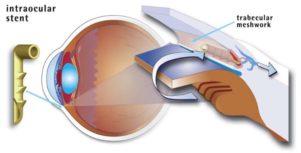1. What causes high eye or intraocular pressure?
Your eye uses an intricate fluid outflow system to keep it balanced and healthy. At the center of this
system is the trabecular meshwork. In patients with open-angle glaucoma, a blockage in the
trabecular meshwork keeps the fluid in your eye from draining properly. When this happens, fluid
backs up and eye pressure rises.
2. How does iStent lower eye pressure?
iStent is designed to create a permanent opening in your eye’s drainage system to improve the
outflow of fluid from your eyes. By increasing fluid outflow, iStent lowers pressure within the eye.
3. How big is the stent?
iStent is tiny. It is the smallest medical device ever approved by the FDA. It is so small you won’t be
able to see or feel it after the procedure is done.
4. Is iStent safe?
Yes. iStent is a safe glaucoma treatment that has been approved by the FDA for mild to moderate
open-angle glaucoma.
5. Will I be able to feel or see the iStent in my eye?
No. iStent is so small you won’t be able to see or feel it after the procedure is done.
6. Does iStent hurt?
No. iStent does not hurt. You won’t even be able to feel it after the procedure is done. However, your
eyes will be sore and sensitive after having cataract surgery. Your eye doctor will give you anti-
inflammatory or antibiotic eye drops to use for a few weeks.
7. Will I be able to stop taking my glaucoma eye drops?
In a US clinical trial, iStent patients who achieved a target pressure of <21, were more likely not to
need their medications than patients with cataract only surgery.
8. How much does iStent cost?
iStent is covered by Medicare and many private insurance plans. If you are interested in the
procedure, you should ask your doctor to see if your plan includes coverage for iStent.
9. Is iStent right for me?
If you are going to have cataract surgery and are currently taking one or more medications to lower
your eye pressure, you may be a candidate for iStent. Talk to your doctor to find out if iStent is right
for you.

